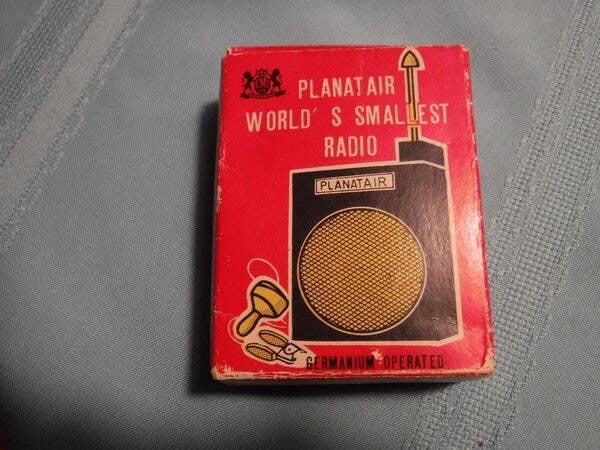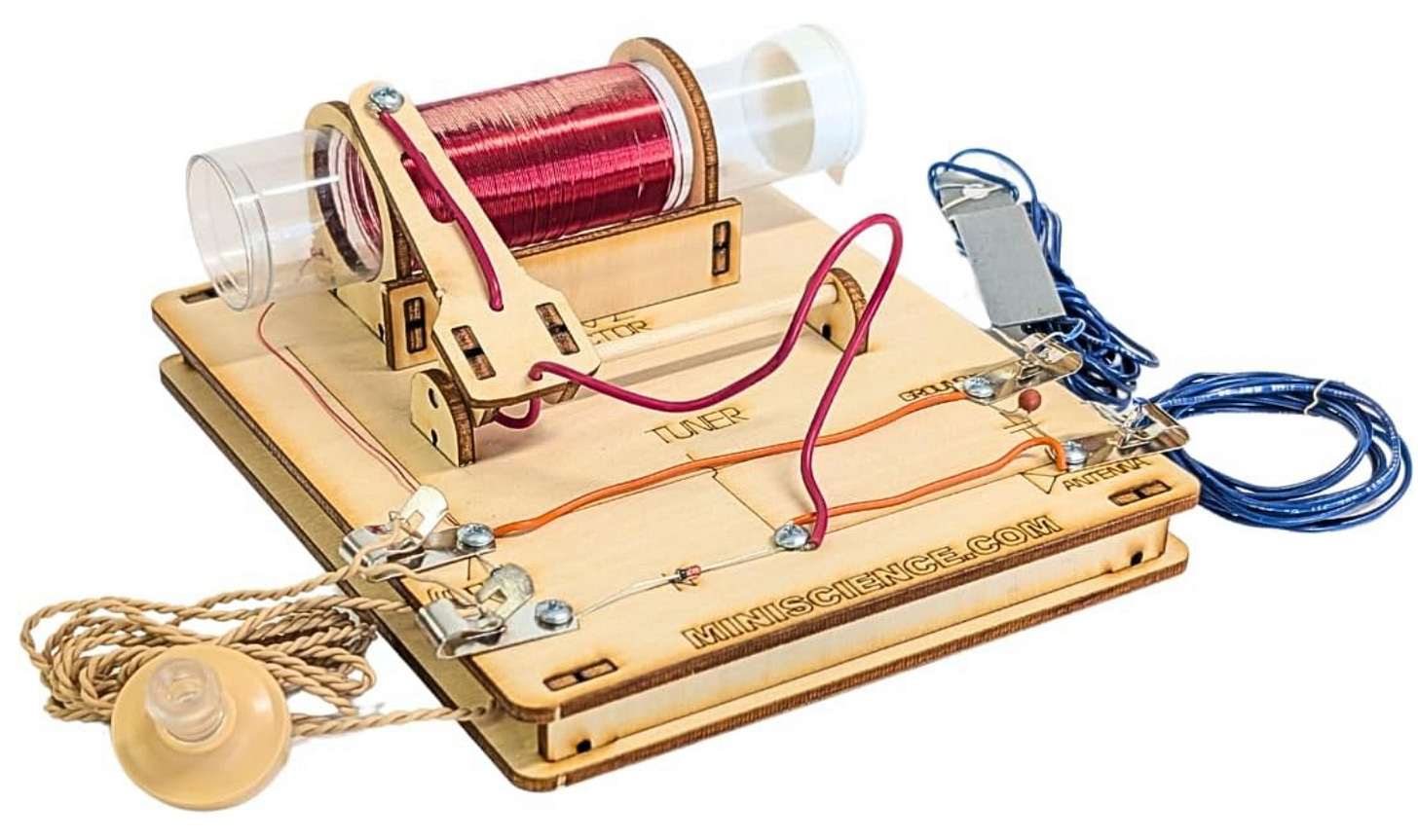Whispers from the Aether
The fascination of hearing far-away radio stations
A crystal radio similar to the one I had. Image via antiqueradios.com member 34sparton.
Long before Amazon existed and brick-and-mortar stores like Costco attempted to carry every possible item in the world, there was Fan Fair. Well, at least in Aurora, Colorado in the period between 1961 and 1965. This huge, architecturally unique store closed not that long after my family moved to Aurora in June of 1965.
The reason? Bad management and the rise of discount stores like Woolco and Kmart. But before those stores took over, we had a chance to shop at Fan Fair a few times. On one of those visits, I had a whole dollar to spend on kid stuff, so I searched everywhere for something that would be out of the ordinary and interesting to my 8-year-old brain.
My attention was captured by a display of transistor radios, but the cheapest 6-transistor pocket radio cost $6.99 — way out of my price range. Then I saw a tiny radio in a colorful box (like that one at the top of this page) with a price tag of $0.79, and I had to have it! I think I also grabbed a couple of comic books with my change, and happily ran out to the new family car (a maroon 1965 Chevrolet Impala station wagon that got about 9 miles per gallon in city driving) with my purchases in hand.
Now, for some reason I didn’t want to let the rest of the family in on what I had bought. We had a nice “table top” transistor radio in the kitchen that Mom controlled, and I knew Dad did ham radios as a hobby, so I hid this little device to myself. I was planning to listen to one of the local pop music stations — probably KIMN, which was verboten on the family’s kitchen radio — all on my own. I was a rebel!
Image via antiqueradios.com member 34sparton. My radio looked like this, except it was red with a gold tinted “speaker” (it wasn’t a speaker…)
What I didn’t realize when I got the radio home and finally looked at it carefully was that it wasn’t a transistor radio. In fact, it didn’t even come with a 9-volt battery or need one. After looking at the rather confusing instructions, I figured out that you hooked it up to something metal using a wire with an alligator clip on one end, plugged the hearing-aid type earphone into your ear, and then moved a little rod in or out to tune in an AM station. It was called a crystal radio… more about that later.
I took it out to our back yard and dutifully clipped the alligator clip to our chain link fence, which was made of galvanized steel. I could hear something whispering in my ear, but it wasn’t very loud. Hmmm…
Back in the house, I found that the bottom of my bed frame was steel and tried that as my “antenna”. Success! I could actually hear a radio station, although I remember being dejected that it was a local “holy roller” religious programming station. I tried the tuner, and gleefully found a few more stations — one was KOA, a local news and music station (still around) that broadcast with a 50,000-Watt transmitter so it was the easiest to hear. KIMN? No such luck.
I was keeping my radio listening a secret, so I decided to listen at night after I went to bed. I’d sneak the radio out, attach the alligator clip to the bed frame, and see what I could pick up. Soon I started hearing radio stations from other places! St. Louis, Missouri — KMOX. WGN — Chicago. WSM — Nashville, Tennessee, although I didn’t appreciate the country music they played in those days.
I attempted to hear the same stations during the day with no luck, which was discouraging because my friends didn’t believe that I was hearing stuff from those far away cities. Later, I found out about ionospheric skip, a phenomenon in which radio waves bounce off of that layer of the earth’s atmosphere and sometimes allow broadcasts to be heard hundreds of miles away. To a kid in Colorado, it was magical to hear “local” news and ads from remote places. I also got my first introduction to major league baseball, even though I was quickly bored listening to it.
Some stations were audible during the day, but disappeared at sunset. Because of that same atmospheric effect that let me hear stations from other parts of the country at night, many AM stations had to either power down or shut off at sunset. That’s still required by the Federal Communications Commission in order for these stations to avoid interfering with other broadcasters.
There was one station in particular that had a rather sad piece of classical music that they would play as they were powering down. I don’t know what the piece was or who wrote it, but I always felt melancholy when I heard it. Someone at the station must have decided that it was appropriate for a broadcast “dying” at night.
That little red crystal radio didn’t last too long. At one point I forgot to remove the alligator clip from the bed frame when I was getting ready to put the radio away, and the clip and the wire that went into it parted ways. I could have had the radio back in order immediately if I had asked my dad to solder the clip back to the wire, but I didn’t want him to know about that radio for some reason known only to my pre-adolescent mind. As a workaround I just held the bare wire to the bed frame, which made it impossible to go to sleep listening to those distant radio stations. Eventually the radio went the way of all broken toys and ended up in the trash. For some reason, it never left my memory.
Make Your Own Crystal Radio!
I was reminded of my little crystal radio while watching the excellent World War 2 miniseries “Masters of the Air”, in which one of the characters builds a radio receiver from scrounged materials so they can clandestinely hear news of the war while languishing in a German POW camp. Radios based on vacuum tube amplifiers were state-of-the-art at that time, but in the early days of radio — about 1914 until the middle of the 1920s — crystal radio sets were widespread, and the character in the series had built one as a child.
There are actually quite a few online articles and YouTube videos for learning how to make your very own crystal radio, but it’s probably cheaper to purchase all the parts as a kit instead of trying to find a diode here, a resistor there, and a high-impedance earphone somewhere else.
Sure enough, guess where you can buy a crystal radio kit? Amazon! It’ll only lighten your wallet by $35, but think of the bragging rights you’ll have when you tell the world that you’ve built your own radio, just like Gale “Buck” Cleven did in Masters of the Air!
It’s not as pretty as my little plastic crystal radio and some assembly is required, but here’s your chance to build your own! Here’s the Amazon link.
How Crystal Radios Work
Despite having earned an amateur radio General license, I still really don’t understand how this stupid little radio worked - hey, I was a civil engineer, not an electrical engineer. While researching this article, I finally learned what had eluded me for so many years.
Radio signals are essentially medium frequency (kilohertz, or thousands of vibrations per second) electromagnetic waves that are broadcast from a tall metallic antenna. On the radio receiver side, the antenna (the bed frame or a long wire) picks up the radio signal and the crude circuitry creates a very weak electrical current. That electricity flows through the radio and is adjusted by the tuner to select a broadcast at a particular frequency.
This diagram shows the AM radio wave (top) and how the germanium diode rectifies the full carrier wave that is filtered into an audio signal (bottom) by a capacitor. That audio signal is heard through the earphone. I’m sure my explanation is missing a few steps, but hopefully you get the general idea.
Over the years since, I’ve had transistor radios, crappy car radios, mammoth AM/FM/Stereo receivers with amplifiers that are partly to blame for my current hearing loss, and now listen to most of my music either through SiriusXM satellite radio when we’re in our RV or through online means (Apple Audio, Spotify, etc…). Radio lost its attraction for me after years of listening to stations on the way to and from work in my car, putting up with endless, repetitive ads. Even so, I’ll always have fond memories of that cheap little crystal radio whispering songs and baseball play-by-plays into my ear at night.
Could you do me a favor? If you were even mildly entertained by this post or learned something you didn’t know before, could you please “Like” this by clicking/tapping that “heart emoji” at the top of the page. And if you’d like to see more of my trips down memory lane, subscribe to LifeBits for free to get this in your email inbox every time a new post oozes out of my brain. Real fans can subscribe for $5 a month and support my work.
Until next time… don’t go deaf listening to flyback transformers.




